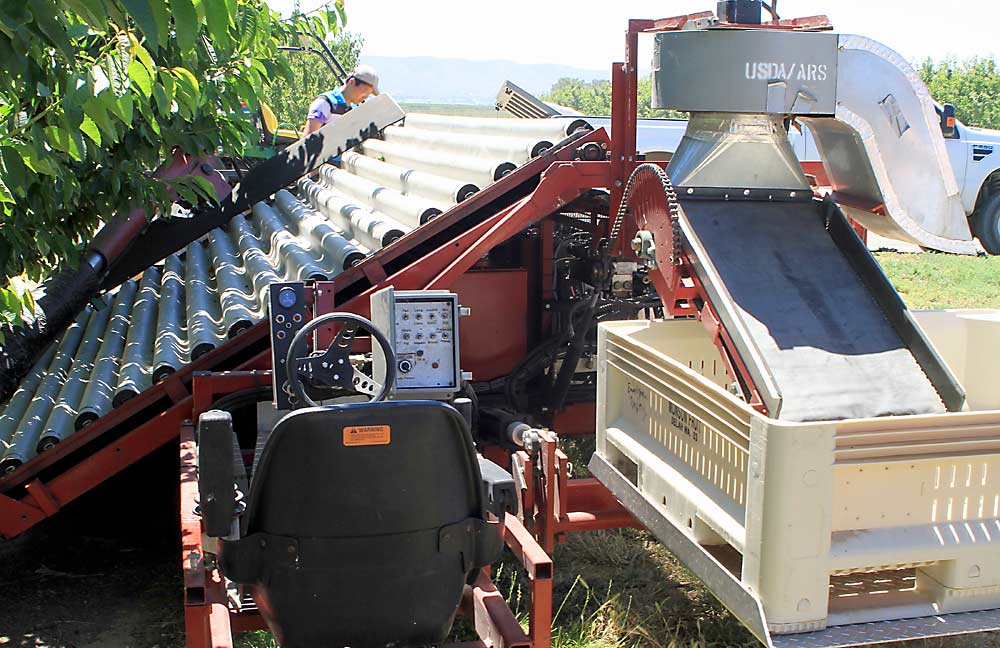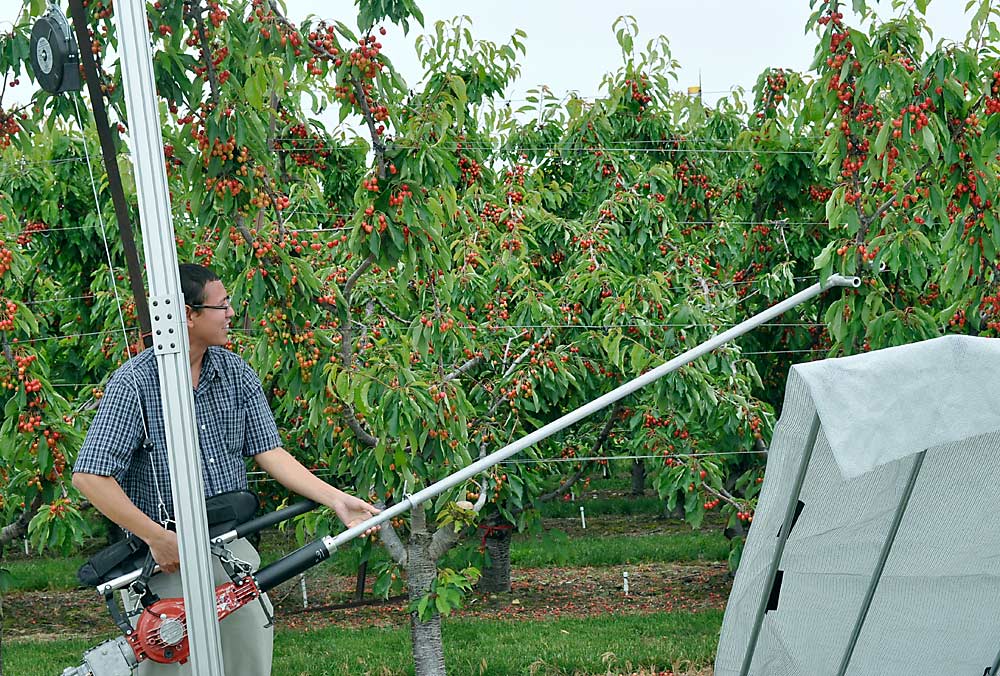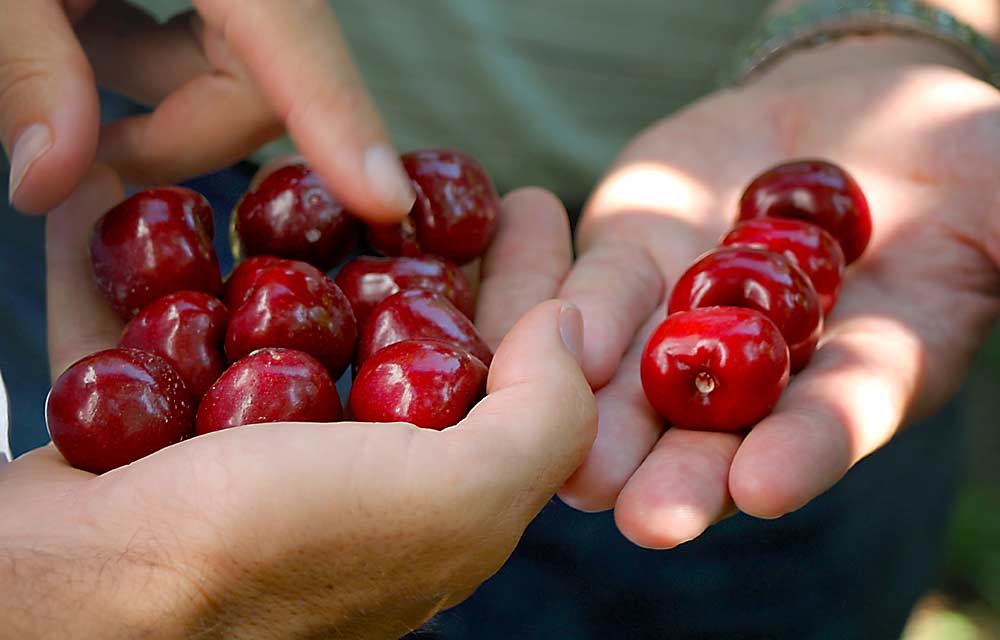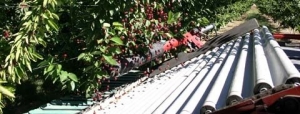
Remember that old mechanical sweet cherry harvester prototype?
It might be time to dust it off and fire it back up, a few industry leaders have said. Labor costs are rising, and more cherries grow on trellises, lending themselves to mechanization.
“We need to look toward the future,” said Dena Ybarra, the current cherry committee chair of the Washington Tree Fruit Research Commission.
Enthusiasm for machine harvesting sweet cherries, once a well-funded ambition, fizzled roughly a decade ago because of retailers’ reluctance to purchase stem-free cherries and some grower concerns about devaluing the fruit.
Researchers, for their part, never abandoned the idea, although without ongoing funding, it was pushed to the back burner. Each year, a team at Washington State University in Prosser still harvests at least a few trees using a handheld shake-and-catch machine.
“There is a little bit of work still going on,” said Manoj Karkee, a WSU biological systems engineer at the Center for Precision and Automated Agricultural Systems in Prosser. “We believe it needs to be continued, and we haven’t given up.”
Yakima-area grower Bob Harris, who collaborated on machine harvest projects with researchers from WSU and West Virginia, hasn’t given up either. In fact, Harris has revamped a version of the concept on his own. He has second-year trees now that he plans to cultivate as bushes, harvesting them with an over-the-row blueberry picking machine. He estimates they will yield 12 to 14 tons per acre, based on trials with tart cherries.
Recently, packers have been asking him about it again.
“I think we were ahead of our time,” Harris said. “But it was really doable, and I really think it’s going to happen.”
History
Over the past two decades, the Northwest cherry industry came close to making machine harvest a reality. In the early 2000s, the Washington Tree Fruit Research Commission funded work by Donald Peterson, a U.S. Department of Agriculture engineer at the Appalachian Fruit Research Station in Kearneysville, West Virginia. Harris, Washington grower Denny Hayden and WSU cherry horticulturist Matt Whiting collaborated. They declared themselves ready to transfer the technology to commercial manufacturers, according to the final commission report.
In 2009, Whiting secured a $4 million grant from the USDA’s Specialty Crop Research Initiative program and continued to work with Harris and Hayden, who invested some of their own money to help the projects. He organized tree architecture trials, quality measurements, economic studies and consumer reaction surveys.
Engineers tinkered with different ways of shaking and catching fruit. They ended up using two mirrored machines on opposite sides of the row with conveyor catch plates and a bar-style end effector that pressed against the leaders to vibrate the cherries loose. One person could operate it. Whiting estimated it would be 50 times as fast as one picker with a bucket. They also came up with a handheld model with a long arm, which they estimate triples the speed of hand labor.

Hayden and Harris treated the cherries with ethephon, a growth regulator, to create an abscission zone for the cherries to more easily detach from their stems. Some varieties, such as Skeena, worked better than others.
Meanwhile, they developed a market with Costco and Sam’s Club for the clamshell-packaged fruit. Before the days of Yelp, consumers mailed response forms to the growers, saying they liked the cherries and didn’t miss the stems. They usually didn’t even notice. Harris still has a drawer full of the letters. “We were overwhelmed with the people who wrote,” he said.
Retailers just liked stems
However, they couldn’t convince other retailers, who viewed stems as a way to measure fruit freshness. Hayden and Harris abandoned the market after three years to avoid the risk of too much investment for only two retailers, even big ones.
Whiting finds the history frustrating. He has spent a large chunk of his career on projects related to mechanical harvest and has research showing the stems don’t affect the fruit quality. In fact, stems shrivel long before cherries go bad.
“The lack of commercial adoption remains kind of baffling to me,” Whiting said.
Not all growers were on board, either, Whiting said. Some worried machine harvesting would flood the market with cheap, low-quality cherries.

Today, the mirror-image machines sit idle in a warehouse at WSU’s Irrigated Agriculture Research and Extension Center in Prosser, but Whiting and his colleagues hope to resurrect the project.
Meanwhile, the Washington Tree Fruit Research Commission called automation in the pruning and harvesting of cherries an area of high interest, just behind the highest priorities of spotted wing drosophila, little cherry disease and powdery mildew, at the 2019 research review. Among the questions was how to remove cherries while leaving the stem intact.
However, industry officials have not given up on stem-free cherries. Chelan Fresh sells 16-ounce convenience cups of cherries that have lost their stems in the packing process. Sold at deli counters and specialty markets, the cups come complete with a seed reservoir built into the lid and fetch a premium in Manhattan and urban Mexican markets. The North Central Washington marketing company has also discussed the idea with the Seattle Mariners, as a ballpark alternative to peanuts and beer.
“Customers are accepting of (stem-free cherries) to a point, depending on the package,” said Mac Riggan, Chelan Fresh director of marketing.
Meanwhile, shoppers may simply have to get used to mechanically harvested stem-free cherries, Riggan and others say. Labor concerns will eventually overcome anyone’s reluctance.
“I don’t think retailers will dictate if we do it anymore,” said Harris, whose friends call him “The Godfather of Stem-free.” “I think labor prices will dictate.” •
—by Ross Courtney







Leave A Comment